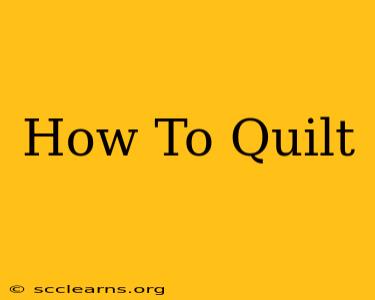Quilting is a rewarding craft that combines sewing, design, and creativity to produce beautiful and cozy textiles. Whether you're a seasoned sewer or a complete beginner, this guide will walk you through the essential steps to create your first quilt. We'll cover everything from choosing fabrics to binding your finished masterpiece. Let's dive in!
Choosing Your Fabrics and Supplies
The first step in your quilting journey is selecting your fabrics. The possibilities are endless! Consider the following:
Fabric Selection:
- Cotton: This is the most popular choice for quilting due to its durability, washability, and wide variety of colors and patterns. Look for quilting cotton specifically designed for its weight and strength.
- Flannel: For a softer, cozier quilt, flannel is a fantastic option. Keep in mind that it can be slightly more challenging to work with than cotton.
- Silk: While luxurious, silk is more delicate and requires more experience.
Tip: Pre-washing your fabrics is crucial to prevent shrinkage after your quilt is completed.
Essential Supplies:
- Rotary Cutter & Mat: These tools make cutting fabric quick and accurate.
- Iron & Ironing Board: Essential for pressing seams and creating crisp lines.
- Sewing Machine: A machine is highly recommended for quilting, though hand-quilting is also an option (though more time-consuming).
- Quilting Pins or Clips: To hold layers together securely while sewing.
- Seam Ripper: For those inevitable mistakes.
- Measuring Tape: Accurate measurements are key!
- Thread: Choose a thread that matches your fabric or complements the overall design.
Planning Your Quilt Design
Before you start cutting, plan your quilt design. Even simple designs require a bit of planning.
Simple Quilt Designs for Beginners:
- Nine-Patch: A classic beginner-friendly design made from nine equal squares.
- Log Cabin: This design uses strips of fabric sewn around a central square.
- Railroad Tracks: Simple and visually appealing using long rectangular strips.
Choosing a Quilt Size:
Start small! A lap quilt or baby quilt is a perfect project for beginners. Larger quilts require more time and fabric.
Cutting Your Fabric
Accurate cutting is vital for a well-made quilt. Here's how to proceed:
- Use a rotary cutter and mat for precise cuts.
- Cut your fabric according to your chosen pattern instructions.
- Keep your fabric squares organized. Label them clearly!
Sewing the Quilt Blocks
Once your fabric is cut, it's time to start sewing!
- Follow your chosen pattern's instructions. Most patterns will guide you step-by-step.
- Press your seams carefully. This helps prevent bulk and creates a neater finish.
- Sew accurately. Straight seams are essential for a beautiful quilt.
Assembling the Quilt Top
After completing your individual blocks, assemble the quilt top by sewing the blocks together to create your desired layout.
Layering and Quilting
This is where the magic happens.
- Layer your quilt top, batting, and backing fabric. Ensure the layers are smooth and even.
- Baste the layers together. This can be done with safety pins, basting spray, or hand basting stitches.
- Quilt your layers together. This step can be done by hand or machine, creating your chosen quilting design. Simple straight lines or a meandering stitch are great options for beginners.
Binding Your Quilt
The final step is binding, which gives your quilt a professional finish.
- Cut your binding strips. The strips should be long enough to go around all four sides of your quilt.
- Sew the binding to the quilt. Fold the binding over the edge, and sew it in place.
- Finish the binding by hand or machine.
Congratulations, You've Made a Quilt!
Creating your first quilt is a significant accomplishment. Be proud of your work! With practice, you’ll refine your techniques and create even more stunning quilts. Remember, the key is to have fun and enjoy the process. Happy quilting!

